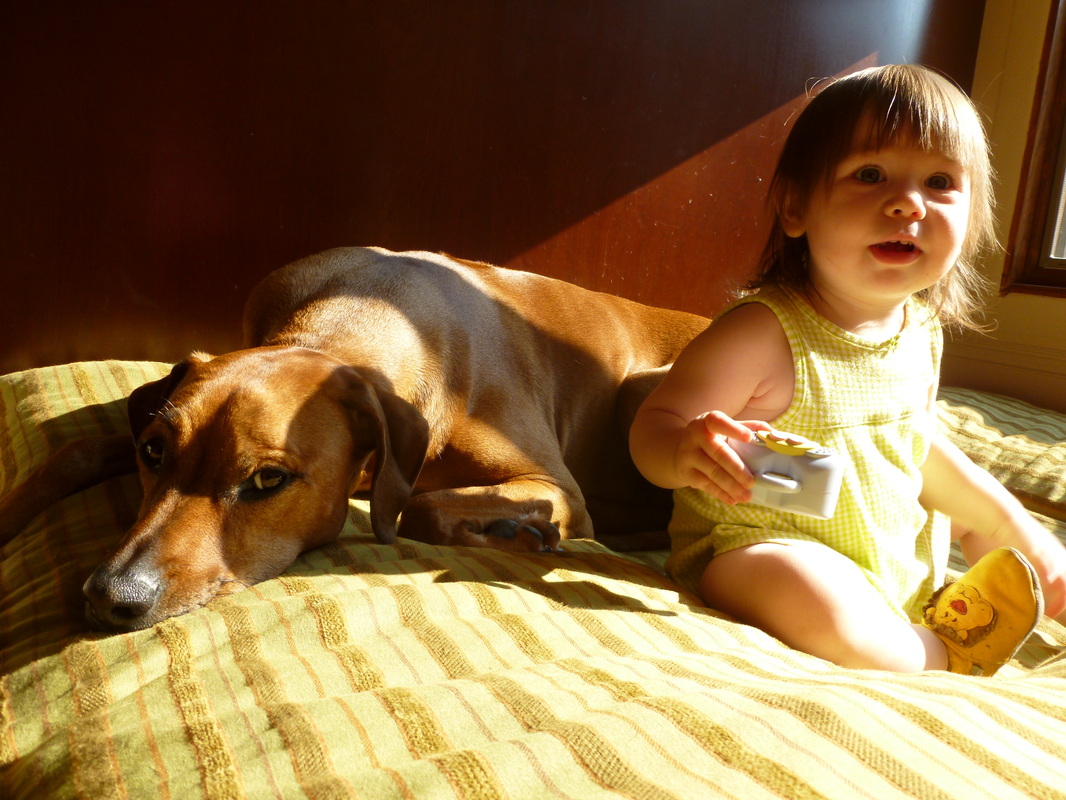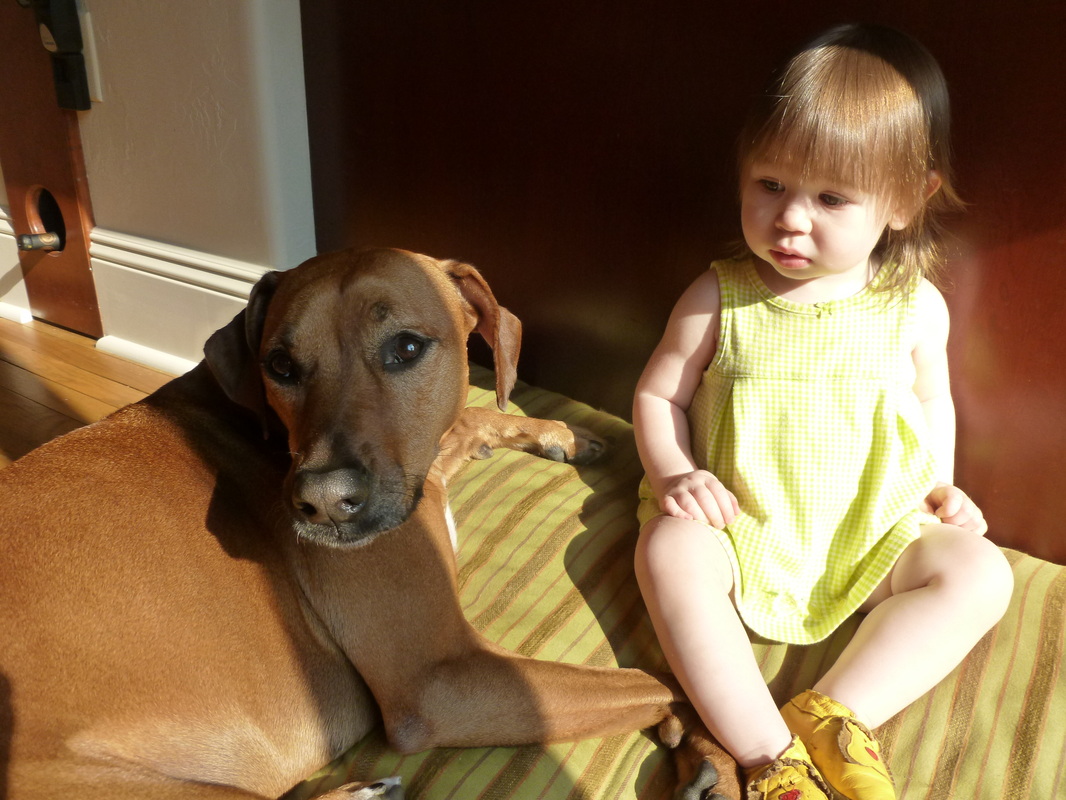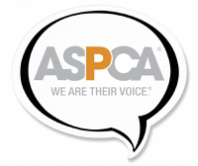- About Us
- Luvakis Rhodesian Ridgebacks
- Current Litter
- Planned Breedings
-
About Our Puppies
-
Information and Articles
- Breed History
- AKC Information
- AKC Breed Standard
- Important Links
- Dog Stuff We Can't Live Without!
- Recommended Readings
- Finding the Right Breeder
- One Puppy or Two?
- Dogs and Kids (Reading Canine Body Language)
- Tutorials: Ear Taping, Ear Wounds, Nail Dremeling >
- Collar Entrapment, Strangulation and CPCR Techniques Article
- What Does Bloat (GDV) Look Like?
- Contact Us
Dogs and Kids
Reading Canine Body Language to Prevent Dog Bites
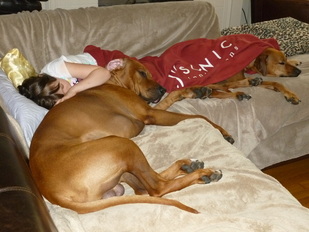
This page is not only for those dog owners who have children (or plan to have children) but also for those dog owners who do not. It is important for children to be taught to respect a dog and be closely supervised when interacting with a dog (yes, even their own family's dog). It is equally important for all dog owners to be the first-line defense in bite prevention by understanding, acknowledging and respecting what their dog is trying to communicate to them through body language.
Each year hundreds of thousands of American children receive medical attention to address dog bite wounds. Most times an adult was supervising the situation, standing with feet of the child and dog when the bit occurred. So, if supervision isn't the issue, what is? The problem is communication. Many people do not know how to interpret what a dog is trying to communicate to them. In situations where the dog is under great stress, not acknowledging what the dog is trying to communicate can result in a bite. It is important to remember that dogs are individuals, just like people. Despite being raised with children and respected by those children, some dogs are still not fond of the loud, strange noises, fast, unpredictable movements and invasion of personal space (hugging and kissing) that comes with living with children. This, for whatever reason, is simply past their comfort level and needs to be acknowledged and respected. A dog does not need to be vicious to bite; merely being pushed past their comfort level often is the cause. Hopefully, through understanding how dogs communicate with us, you can better understand how to "read" their comfort level in different situations, such as interacting with children, thus keeping both dog and child safe.
Each year hundreds of thousands of American children receive medical attention to address dog bite wounds. Most times an adult was supervising the situation, standing with feet of the child and dog when the bit occurred. So, if supervision isn't the issue, what is? The problem is communication. Many people do not know how to interpret what a dog is trying to communicate to them. In situations where the dog is under great stress, not acknowledging what the dog is trying to communicate can result in a bite. It is important to remember that dogs are individuals, just like people. Despite being raised with children and respected by those children, some dogs are still not fond of the loud, strange noises, fast, unpredictable movements and invasion of personal space (hugging and kissing) that comes with living with children. This, for whatever reason, is simply past their comfort level and needs to be acknowledged and respected. A dog does not need to be vicious to bite; merely being pushed past their comfort level often is the cause. Hopefully, through understanding how dogs communicate with us, you can better understand how to "read" their comfort level in different situations, such as interacting with children, thus keeping both dog and child safe.
Common Dog Stress Signals
Identifying the difference between happy dog body language and stressed dog body language can make all the difference when preventing a bite. Happy dog body language is loose, relaxed, and wiggly; look for curves in the dog’s body when it's around a child. Stressed dog body language starts with stiffening, freezing and tightening the body. Additional signs of stress are a diverted gaze, turning their body away, anxious/rough panting or the other extreme, slow, shallow respirations, as well as licking the lips or yawning. These are early signs of a dog that is not comfortable and needs you to take action to improve the situation immediately. By paying attention to a dog's body language, you can help them feel more secure and be the first-line defense to prevent a potential bite.
|
|
|
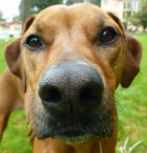
For those concerned about how we were able to capture these examples of common dog stress signals, rest assured, no dog or child was at risk. These were all staged. (As an example, look close in the "Shaking Off" photo. See the tiny droplets of water shimmering in the sunlight as they are being shaken from the dog's coat? We used a water misting bottle to entice the dog to perform this shaking action.)
The dog in these photos is beautiful, wonderful Lilla, and we appreciate her having the patience to allow us to stage these photos with our daughter. Lilla is a therapy dog and especially loves interacting with children. Although the enormous effort to get just the right "look" to exemplify each stress signal took a ton of patience for all involved, we felt photographic examples were the most beneficial to those who visit this page.
Thank you Luvakis Lilla! We ♥ you!
The dog in these photos is beautiful, wonderful Lilla, and we appreciate her having the patience to allow us to stage these photos with our daughter. Lilla is a therapy dog and especially loves interacting with children. Although the enormous effort to get just the right "look" to exemplify each stress signal took a ton of patience for all involved, we felt photographic examples were the most beneficial to those who visit this page.
Thank you Luvakis Lilla! We ♥ you!
For more information on canine behavior, body language and dog bite prevention,
please visit these informative sites and videos...
|
Please take a moment to read Liam's story.
It is important to acknowledge it only take a second and sometimes only one bite to cause a fatal wound. |
|
|
|
|
|
|
|
|


